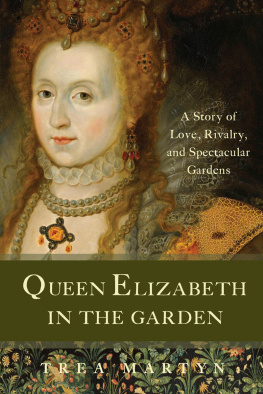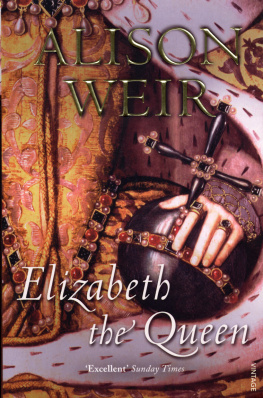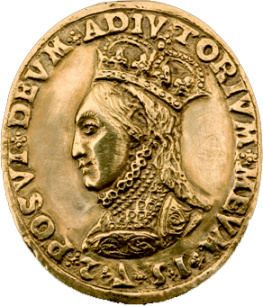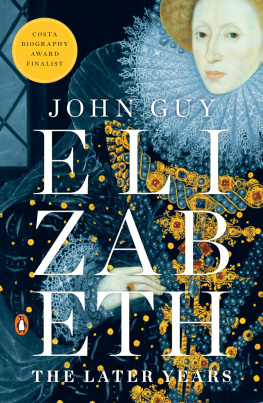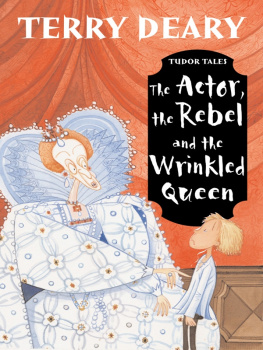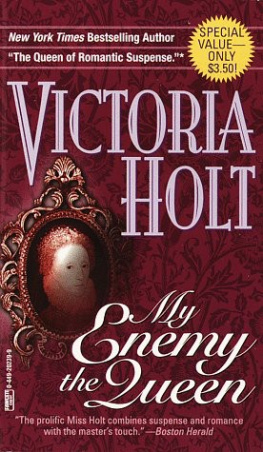
Trea Martyn, 2008
All rights reserved. No part of this book may be reproduced or transmitted in
any form or by any means, electronic or mechanical, including photocopying,
recording or by any information storage and retrieval system, without
permission in writing from the Publisher.
First published in Great Britain in 2008 under the title Elizabeth in the Garden by
Faber and Faber Limited
Published in the United States of America in 2012 by
Blue Bridge
An imprint of
United Tribes Media Inc.
Katonah, New York
www.bluebridgebooks.com
Library of Congress Cataloging-in-Publication Data
Martyn, Trea.
[Elizabeth in the garden]
Queen Elizabeth in the garden : a story of love, rivalry, and spectacular gardens /
Trea Martyn.
p. cm.
First published in Great Britain in 2008 under the title Elizabeth in the garden by
Faber and Faber LimitedT.p. verso.
Includes bibliographical references and index.
ISBN 978-1-933346-36-6
1. GardensEnglandHistory16th century. 2. Elizabeth I, Queen of England, 1533-1603. 3. Burghley, William Cecil, Baron, 1520-1598Homes and haunts. 4. Leicester, Robert Dudley, Earl of, 1532?-1588Homes and haunts. 5. Theobalds (England) 6. Kenilworth Castle (Kenilworth, England) 7. GardensEngland
Design. I. Title.
SB466.G7M27 2011
635.0942dc23
2011038798
Jacket design by Stefan Killen Design
Cover art top: Healy, George Peter Alexander (18131894), after Gerards Marcus
the Younger (ca. 15611635): Queen Elizabeth I of England. 1844.
Photo credit: Runion des Muses Nationaux /Art Resource, NY
Cover art bottom: Tapestry of the miracle of Saint Eligius (Eloy). French 16th c.
Photo credit: Erich Lessing/Art Resource, NY
Printed in the United States of America
10 9 8 7 6 5 4 3 2 1
For my mother and father

Contents
[1]
Princely Pleasures
Many strange herbs, plants and unusual fruits are daily
brought unto us

Woodcut from Thomas Hills Most Briefe and Pleasaunt Treatyse, 1558
THIS IS THE STORY of spectacular gardens and the powerful men who created them in their battle for ascendancy. Queen Elizabeth I was their audience and muse. Inspired by her love of gardens, her favourite of the time Robert Dudley, Earl of Leicester, and her chief minister William Cecil, Lord Burghley, competed for her favour by laying out innovative and extravagant pleasure grounds at their palaces for when she came to visit - which was very often.
Dudleys garden at Kenilworth Castle, in Warwickshire, and Cecils landscape at Theobalds Palace, in Hertfordshire, were masterpieces of Renaissance design. They also enticed Elizabeth to stay longer. Whereas most courtiers could count themselves lucky if she called on them for an afternoon, Dudley and Cecil entertained her for days and weeks at a time. As she played one off against the other, they created gorgeous palaces and landscapes that amazed the world.

The garden at Kenilworth Castle lay within tall stone walls, so that only the tops of the fruit trees and the wooden galleries could be seen from outside. If a passer-by asked what kind of garden it was, he was told that the paths were laid with gold. In fact, they were made of sand and glittered in the sunlight.
The head gardener locked the garden gate and surveyed the scene. His men were raking the sand on the paths, which were as firm to walk on as the seashore when the tide is out. They wore wide-brimmed hats, loose-fitting mantles tied at the waist over long-sleeved shirts and trousers, and soft leather shoes. Everything was looking its best, despite the recent downpours -the covers had just been removed from the flower beds.
It was the second fine day in a row: perfect weather for weeding. The ground was soft, and women were kneeling on the paths between the beds, casting away stones and pulling up weeds by the roots, so as not to damage the expensive plants.
The owner of the garden was away for a few days. The head gardener leant down to smooth greenfly from the petals of a crimson lily, a gift from the English ambassador in Constantinople. At the heart of a maze, a young gardener was trimming the low hedges with a sharp knife. The hedges were made of thyme, and the delicious-smelling cuttings piled up on grass that was planted with daisies and buttercups. This square-shaped labyrinth faced a circular maze with hyssop hedges. Both compartments were surrounded by low wooden fences, which men were repainting black and white.
Halfway down the central avenue, a boy was feeding the fish in the fountain basin. The fountain only played when there were visitors. All was quiet until a carp leapt to steal the bread from the boys fingers. Suddenly, water blasted from the sundial at the top of the fountain and splashed from the highest dish to the bowl and basin below. It was a test run. Moments later, countless tiny jets exploded in all directions from the sides of the basin. Gardeners, painters, labourers and weeders turned to see a blurred shape inside a wall of water. The boy darted down the steps, drenched, but joined in the laughter. He was new to working in these grounds: almost everyone had been caught by the water jokes, at least once. Somewhere out of sight, the head gardener turned a stopcock, and the jets disappeared.
At the corners of the garden, the men returned to their work. They were winding vines around juniper poles which had been bent to form pumpkin-shaped enclosures. One of the bowers was covered with honeysuckle, damask roses and sweet briar. Inside it, a painter was coating a bench with a glistening jasper.
All of this splendour had been put together in less than a year. It followed a style that had now dominated gardens for over half a century. Criss-crossed with paths, the garden was a grid, enclosing geometrical shapes. The patterns were best viewed from the top-floor windows of the castle. The cloistered garden was still seen as the height of sophistication and elegance.
But gardens were about to change. Within a decade, Englands pleasure grounds would look very different - the joke fountain was an early sign. This transformation would be brought about by the rivalry between the two most powerful men in the country.
On this blazing hot day in August i572, the gossip in the garden concerned the Queens repeated visits to the castle. She had been here twice within the last ten days. Out of the blue, in the middle of her official visit to nearby Warwick Castle, she had said that she desired to go to Kenilworth. She had left her household behind, bringing her Lord Treasurer, William Cecil, as her only companion. She had come to enjoy the princely pleasures of Kenilworth: falconry, archery and hunting. Both times, she had stayed for several days, returning to Warwick late at night.
The head gardener did not say a word but kept one ear open to the conversations around him. Everyone knew that the Queen really came to see their master Robert Dudley. But this summer, her unscheduled appearances had caused a scandal. On a whim, she had invited a local official to accompany her and Cecil on her second excursion. The man had been so shocked by what he had witnessed at the castle that, on returning to Warwick, he had reported such things as, some for their untruths, and some for other causes, had been better untold. The scandal had revived the rumours concerning the Queen and her favourite.
Next page
